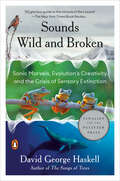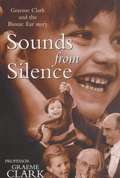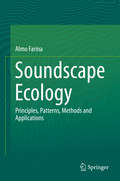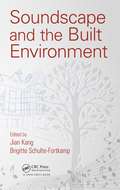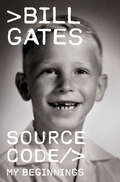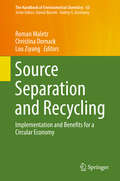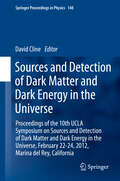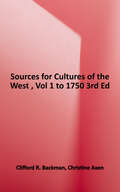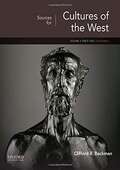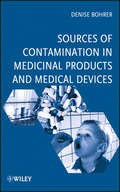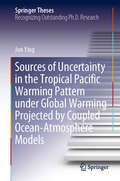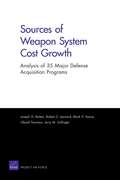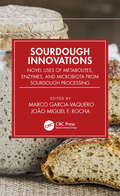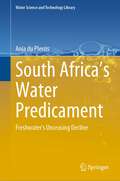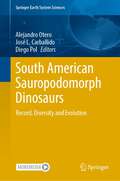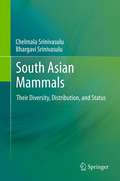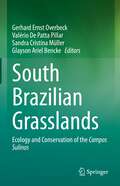- Table View
- List View
Sounds All Around (Let's-Read-and-Find-Out Science 1)
by Wendy PfefferRead and find out about people and animals use different kinds of sounds to communicate in this colorfully illustrated nonfiction picture book.Sounds are all around us. Clap your hands, snap your fingers: You’re making sounds. With colorful illustrations from Anna Chernyshova and engaging text from Wendy Pfeffer, Sounds All Around is a fascinating look into how sound works.This is a clear and appealing science book for early elementary age kids, both at home and in the classroom. It includes a find out more section with additional and updated experiments, such as finding out how sound travels through water. Both the text and the artwork were vetted by Dr. Agnieszka Roginska, Professor of Music Technology at NYU.This is a Level 1 Let's-Read-and-Find-Out, which means the book explores introductory concepts perfect for children in the primary grades. The 100+ titles in this leading nonfiction series are:hands-on and visualacclaimed and trustedgreat for classroomsTop 10 reasons to love LRFOs:Entertain and educate at the same timeHave appealing, child-centered topicsDevelopmentally appropriate for emerging readersFocused; answering questions instead of using survey approachEmploy engaging picture book quality illustrationsUse simple charts and graphics to improve visual literacy skillsFeature hands-on activities to engage young scientistsMeet national science education standardsWritten/illustrated by award-winning authors/illustrators & vetted by an expert in the fieldOver 130 titles in print, meeting a wide range of kids' scientific interestsBooks in this series support the Common Core Learning Standards, Next Generation Science Standards, and the Science, Technology, Engineering, and Math (STEM) standards. Let's-Read-and-Find-Out is the winner of the American Association for the Advancement of Science/Subaru Science Books & Films Prize for Outstanding Science Series.
Sounds Wild and Broken: Sonic Marvels, Evolution's Creativity, and the Crisis of Sensory Extinction
by David George Haskell&“A symphony, filled with the music of life.&” —Elizabeth Kolbert, author of The Sixth ExtinctionA lyrical exploration of the diverse sounds of our planet, the creative processes that produced these marvels, and the perils that sonic diversity now facesWe live on a planet alive with song, music, and speech. David Haskell explores how these wonders came to be. In rain forests shimmering with insect sound and swamps pulsing with frog calls we learn about evolution&’s creative powers. From birds in the Rocky Mountains and on the streets of Paris, we discover how animals learn their songs and adapt to new environments. Below the waves, we hear our kinship to beings as different as snapping shrimp, toadfish, and whales. In the startlingly divergent sonic vibes of the animals of different continents, we experience the legacies of plate tectonics, the deep history of animal groups and their movements around the world, and the quirks of aesthetic evolution. Starting with the origins of animal song and traversing the whole arc of Earth history, Haskell illuminates and celebrates the emergence of the varied sounds of our world. In mammoth ivory flutes from Paleolithic caves, violins in modern concert halls, and electronic music in earbuds, we learn that human music and language belong within this story of ecology and evolution. Yet we are also destroyers, now silencing or smothering many of the sounds of the living Earth. Haskell takes us to threatened forests, noise-filled oceans, and loud city streets, and shows that sonic crises are not mere losses of sensory ornament. Sound is a generative force, and so the erasure of sonic diversity makes the world less creative, just, and beautiful. The appreciation of the beauty and brokenness of sound is therefore an important guide in today&’s convulsions and crises of change and inequity. Sounds Wild and Broken is an invitation to listen, wonder, belong, and act.
Sounds from Silence: Graeme Clark and the Bionic Ear Story
by Graeme ClarkThe author's interest in the development of improved hearing devices for the deaf arose from his interactions with his own father, who lost his hearing. Having worked in a pharmacy, Graham Clark developed a keen interest in pursuing a medical degree. His research and tenacity led him to develop the multiple contact bionic ear. The book takes us on a journey with the author through his life and his perseverance to develp this device.
Soundscape Ecology
by Almo FarinaSoundscape Ecology represents a new branch of ecology and it is the result of the integration of different disciplines like Landscape ecology, Bioacoustics, Acoustic ecology, Biosemiotics, etc. The soundscape that is the object of this discipline, is defined as the acoustic context resulting from natural and human originated sounds and it is considered a relevant environmental proxy for animal and human life. With Soundscape Ecology Almo Farina means to offer a new cultural tool to investigate a partially explored component of the environmental complexity. For this he intends to set the principles of this new discipline, to delineate the epistemic domain in which to develop new ideas and theories and to describe the necessary integration with all the other ecological/environmental disciplines. The book is organized in ten chapters. The first two chapters delineate principles and theory of soundscape ecology. Chapters three and four describe the bioacoustic and communication theories. Chapter five is devoted to the human dimension of soundscape. Chapters six to eight regard the major sonic patterns like noise, choruses and vibrations. Chapter nine is devoted to the methods in soundscape ecology and finally chapter ten describes the application of the soundscape analysis.
Soundscape and the Built Environment
by Jian KangSoundscape Basics and Practical ImplicationsSoundscape research represents a paradigm shift, as it involves human and social sciences and physical measurements to account for the diversity of soundscapes across countries and cultures. Moreover, it treats environmental sounds as a resource rather than a waste. Soundscape and the Built Environment is the first book to systematically discuss soundscape in the built environment. It begins with a presentation of theory and basic background, answering questions such as: what is soundscape, how is it important, and how does it affect people in terms of their health and perception on the acoustic environment. The book then sets out tools for implementing a soundscape approach, with measurement techniques, mapping, and good soundscape practices. It also delivers a series of examples of the application of the soundscape approach in planning, design, and assessment. Discusses soundscape and environmental noise Explores cultural variations and the way they influence soundscape Introduces binaural measurement technology and psychoacoustics Examines the physical, psychological, and physiological restorative mechanism of high-quality acoustic environments Presents soundscape mapping based on human perception of sound sources Includes real-world examples and case studies highlighting the key issues in soundscape intervention Soundscape and the Built Environment is written by a group of leading international figures and derives from a four-year EU COST project on Soundscapes of European Cities and Landscapes. It presents a consensus on the current state of the art and is not merely a collection of different views. It is written for acoustic consultants, urban planners, designers and policy makers, as well as for graduate students and researchers.
Source Code: My Beginnings
by Bill GatesThe origin story of one of the most influential and transformative business leaders and philanthropists of the modern age The business triumphs of Bill Gates are widely known: the twenty-year-old who dropped out of Harvard to start a software company that became an industry giant and changed the way the world works and lives; the billionaire many times over who turned his attention to philanthropic pursuits to address climate change, global health, and U.S. education. Source Code is not about Microsoft or the Gates Foundation or the future of technology. It&’s the human, personal story of how Bill Gates became who he is today: his childhood, his early passions and pursuits. It&’s the story of his principled grandmother and ambitious parents, his first deep friendships and the sudden death of his best friend; of his struggles to fit in and his discovery of a world of coding and computers in the dawn of a new era; of embarking in his early teens on a path that took him from midnight escapades at a nearby computer center to his college dorm room, where he sparked a revolution that would change the world. Bill Gates tells this, his own story, for the first time: wise, warm, revealing, it&’s a fascinating portrait of an American life.
Source Code: My Beginnings
by Bill GatesNamed one of the Most Anticipated Releases of 2025 by The New York Times, The Times, Financial Times and BBC. <p> The origin story of one of the most influential and transformative business leaders and philanthropists of the modern age. The business triumphs of Bill Gates are widely known: the twenty-year-old who dropped out of Harvard to start a software company that became an industry giant and changed the way the world works and lives; the billionaire many times over who turned his attention to philanthropic pursuits to address climate change, global health, and U.S. education. <p> Source Code is not about Microsoft or the Gates Foundation or the future of technology. It’s the human, personal story of how Bill Gates became who he is today: his childhood, his early passions and pursuits. It’s the story of his principled grandmother and ambitious parents, his first deep friendships and the sudden death of his best friend; of his struggles to fit in and his discovery of a world of coding and computers in the dawn of a new era; of embarking in his early teens on a path that took him from midnight escapades at a nearby computer center to his college dorm room, where he sparked a revolution that would change the world. Bill Gates tells this, his own story, for the first time: wise, warm, revealing, it’s a fascinating portrait of an American life. <b>New York Times Bestseller</b>
Source Mechanisms of Earthquakes: Theory and Practice
by Elisa Buforn Agustín Udías Agustín Udías Raúl Madariaga Raúl MadariagaThis book presents an innovative new approach to studying source mechanisms of earthquakes, combining theory and observation in a unified methodology, with a key focus on the mechanics governing fault failures. It explains source mechanisms by building from fundamental concepts such as the equations of elasticity theory to more advanced problems including dislocation theory, kinematic models and fracture dynamics. The theory is presented first in student-friendly form using consistent notation throughout, and with full, detailed mathematical derivations that enable students to follow each step. Later chapters explain the widely-used practical modelling methods for source mechanism determination, linking clearly to the theoretical foundations, and highlighting the processing of digital seismological data. Providing a unique balance between application techniques and theory, this is an ideal guide for graduate students and researchers in seismology, tectonophysics, geodynamics and geomechanics, and a valuable practical resource for professionals working in seismic hazard assessment and seismic engineering.
Source Separation and Recycling: Implementation And Benefits For A Circular Economy (The Handbook of Environmental Chemistry #63)
by Roman Maletz Christina Dornack Lou ZiyangSource separation of waste and subsequent recycling processes are promising solutions on the road to a circular economy. They reduce waste disposal and the need for resource deployment, while also producing secondary raw materials; as such, they have a significant effect on climate protection. This book presents source separation technologies and related aspects that form the basis for efficient recycling and a modern approach to waste management. It examines legislational drivers and policy aspects of adequate waste collection schemes, as well as segregation technologies and the success factors for their implementation. Summarizing the outcomes of a Sino-German workshop, the focus of this volume is mainly on the current situation in China and Germany. However, the findings are applicable to a broad range of situations and regions around the world. In addition, the book demonstrates the relevance of source separation for climate protection and describes alternative separation technologies. Given the breadth and depth of its coverage, the volume will appeal to environmental scientists, engineers, economists, waste managers and policymakers alike.
Sources and Detection of Dark Matter and Dark Energy in the Universe
by David ClineThese proceedings provide the latest results on dark matter and dark energy research. The UCLA Department of Physics and Astronomy hosted its tenth Dark Matter and Dark Energy conference in Marina del Rey and brought together all the leaders in the field. The symposium provided a scientific forum for the latest discussions in the field. Topics covered at the symposium: *Status of measurements of the equation of state of dark energy and new experiments *The search for missing energy events at the LHC and implications for dark matter search *Theoretical calculations on all forms of dark matter (SUSY, axions, sterile neutrinos, etc. ) *Status of the indirect search for dark matter *Status of the direct search for dark matter in detectors around the world *The low-mass wimp search region *The next generation of very large dark matter detectors *New underground laboratories for dark matter search
Sources for Cultures of the West: Volume 1: To 1750
by Clifford R. Backman Christine AxenDesigned to accompany Cultures of the West: Volume 1: To 1750, Third Edition (2019), and Cultures of the West: Volume 2: Since 1350, Third Edition (2019), by Clifford R. Backman, the third editions of Sources for Cultures of the West, Volume 1: To 1750 and Sources for Cultures of the West, Volume 2: Since 1350 feature approximately six written sources per chapter that highlight key themes in the study of Western civilization. Each of the 189 sources is accompanied by a headnote. Each volume begins with a special unit, "How to Read a Primary Source," that provides students with important advice on how to work with textual documents in studying the past. The third edition includes twenty-one new sources.
Sources for Cultures of the West: Volume 2: Since 1350
by Clifford R. Backman Christine AxenDesigned to accompany Cultures of the West: Volume 1: To 1750, Third Edition (2019), and Cultures of the West: Volume 2: Since 1350, Third Edition (2019), by Clifford R. Backman, the third editions of Sources for Cultures of the West, Volume 1: To 1750 and Sources for Cultures of the West,Volume 2: Since 1350 feature approximately six written sources per chapter that highlight key themes in the study of Western civilization. Each of the 189 sources is accompanied by a headnote. Each volume begins with a special unit, "How to Read a Primary Source," that provides students withimportant advice on how to work with textual documents in studying the past. The third edition includes twenty-one new sources.
Sources of Contamination in Medicinal Products and Medical Devices
by Denise BohrerThe first one-volume guide to sources of contamination in pharmaceuticals and medical devicesMost books dealing with contaminants in medicinal products often focus on analytical methods for detecting nonspecific impurities. Key to the work of the pharmaceutical chemist, this unique reference helps identify the sources of contamination in medicinal and pharmaceutical products and medical devices. Divided into three parts, Sources of Contamination in Medicinal Products and Medical Devices covers chemical, microbiological, and physical (particulate matter) contamination, including those originating from sterilization procedures.As compelling as a medical documentary, the book sheds light on how impurities and contaminants can enter the human body transported via a specific product or treatment. Focusing on only those medicinal products and medical devices that may lead to exposure to contaminants harmful to human health, the book offers a comprehensive, systematic look at the entire universe of medical contamination:Chemical contaminants including residual solvents, catalyst residuals, and genotoxic impurities in active pharmaceutical ingredients (APIs)Diagnostic imaging agents (i.e., radiopharmaceuticals and contrast agents)Microbiological and endotoxin contamination involving single and multiple dose products, medical devices, and biofilmsContamination from sterilization procedures, residuals from radiation sterilization, ionizing radiation on packaging materials and medical devicesMedicinal gases and volatile anestheticsBiopharmaceuticals including recombinant DNA technology productsExtractables and leachables from containers made of glass, plastics, and metalEach section of the book contains information on what contaminants could be expected in a particular product, and how they were generated and reached that product. With up-to-date regulatory guidelines for determining contamination, as well as methods for assessing, quantifying, avoiding and removing contaminants, Sources of Contamination in Medicinal Products and Medical Devices is essential to fully understanding the specific threats that undermine the safety of medicines and medical devices.
Sources of Uncertainty in the Tropical Pacific Warming Pattern under Global Warming Projected by Coupled Ocean-Atmosphere Models (Springer Theses)
by Jun YingThis book discusses the sources of uncertainty in future model projections of the tropical Pacific SST warming pattern under global warming. It mainly focuses on cloud radiation feedback and ocean dynamical effect, which reveal to be the two greatest sources of uncertainty in the tropical Pacific SST warming pattern. Moreover, the book presents a correction for model projections of the tropical Pacific SST warming pattern based on the concept of “observational constraints”; the corrected projection exhibits a more El Niño-like warming pattern.
Sources of Weapon System Cost Growth: Analysis of 35 Major Defense Acquisition Programs
by Jerry M. Sollinger Mark V. Arena Joseph G. Bolten Robert S. Leonard Obaid YounossiThis analysis uses data from Selected Acquisition Reports to determine the causes of cost growth in 35 mature major defense acquisition programs. Four major sources of growth are identified: (1) errors in estimation and scheduling, (2) decisions by the government, (3) financial matters, and (4) miscellaneous. The analysis shows that more than two-thirds of cost growth (measured as simple averages) is caused by decisions, most of which involve quantity changes, requirements growth, and schedule changes.
Sources, Sinks and Sustainability
by Jianguo Liu Vanessa Hull Anita T. Morzillo John A. WiensSource-sink theories provide a simple yet powerful framework for understanding how the patterns, processes and dynamics of ecological systems vary and interact over space and time. Integrating multiple research fields, including population biology and landscape ecology, this book presents the latest advances in source-sink theories, methods and applications in the conservation and management of natural resources and biodiversity. The interdisciplinary team of authors uses detailed case studies, innovative field experiments and modeling, and comprehensive syntheses to incorporate source-sink ideas into research and management, and explores how sustainability can be achieved in today's increasingly fragile human-dominated ecosystems. Providing a comprehensive picture of source-sink research as well as tangible applications to real world conservation issues, this book is ideal for graduate students, researchers, natural-resource managers and policy makers.
Sourdough Innovations: Novel Uses of Metabolites, Enzymes, and Microbiota from Sourdough Processing
by Marco Garcia-Vaquero and João Miguel F. RochaSourdough fermentation was probably one of the first microbial processes employed by mankind for the production and preservation of food. This practice is still widely used worldwide due to the distinct sensorial and health properties attributed to these products. Traditional sourdough bread is achieved by spontaneous fermentations, leading to natural selections of microorganisms (mainly yeast and lactic acid bacteria) with health benefits for the consumers’ microbiota. However, multiple opportunities are currently underexploited through the entire sourdough value chain. Sourdough Innovations: Novel Uses of Metabolites, Enzymes, and Microbiota from Sourdough Processing summarizes the latest scientific knowledge and current opportunities of sourdough technology at biomass, microbiota and enzymatic levels described in three distinctive sections. Section I covers the fermentation process of cereals and non-cereals to produce sourdough-containing compounds with health-enhancement benefits. Section II includes novel advances in sourdough enzymology, and last, Section III explores various applications of sourdough microbiota as antimicrobial and probiotic microorganisms and opportunities to be included in both food and non-food applications. Key Features: Includes extensive information on the use of innovative or emerging technologies aiming to promote circular exploitation systems. Promotes the full use of the cereal and non-cereal sourdough metabolites. Covers the functionality of sourdough microorganisms and functional compounds, and future exploitation of some of them in the field of nutraceuticals or functional foods. Sourdough Innovations is unique in its examination of health beneficial compounds through the downstream processing of sourdough from cereals, microbiota, and enzymes. It is a great source for academic staff and scientists within the broad area of food science who are researching, lecturing, or developing their professional careers in food microbiology, food chemistry, food processing, and food technology, including bio-process engineers interested in the development of novel technological improvements in sourdough processing.
Sourdough Microbiota and Starter Cultures for Industry
by João Miguel Ferreira da Rocha Elaine Berger Ceresino Grazina Juodeikiene Susanne Miescher SchwenningerTraditional sourdough bread refers to spontaneous fermentation of cereals by lactic acid bacteria and yeasts, leading to natural selections of microorganisms. The metabolic activity of these microorganisms promotes the formation of organic acids, flavor development and leavening in food matrices, which most know as sourdough bread. This bread is still widely manufactured at farm level across Europe and worldwide, being highly appreciated by consumers for its distinct flavor, texture, healthy attributes and natural origin. Sourdough bread is expected to grow 6.9% annually through 2023. Once stagnant, the bread market has experienced a revival specifically through sourdough bread consumption. Consumers have been avoiding bread in the recent years due to the presence of extra ingredients such as chemical dough conditioners, preservatives and added sugar. However, the increasing popularity of fermented foods and their multiple health benefits are prompting the growthof sourdough market. This fast-growing market has been demanding a dynamic response from industries producing starter cultures to accelerate sourdough fermented bread production in increasing quantities while keeping its “made-for-you” characteristics. By bringing together top sourdough experts in Europe and beyond, this book compiles the latest knowledge in all areas of sourdough starter culture and advantages in using sourdough fermentation. Sourdough Microbiota and Starter Cultures for Industry supplies a biosciences’ audience with a hands on view of the latest advances from sourdough microbiota characterization to starter culture potentials targeting industrial application, including specific techno-functional and safety improvements obtained by clean-labeling strategies. Insights on health and improved quality shed light on new shifting consumer preferences and why choosing sourdough fermentation is a great expansion opportunity in one’s portfolio as thescience behind sourdough starter cultures meets improved nutrition-impact opportunities. This text teaches methods to exploit sourdough technology through the entire value chain from sourdough natural microflora through the development of novel starter cultures for producing fermented food, introducing the advantages that sourdough fermentation offers for improving the sensorial, technological and nutritional properties of breads.
South Africa’s Water Predicament: Freshwater’s Unceasing Decline (Water Science and Technology Library #101)
by Anja du PlessisThe book provides a critical evaluation of South Africa’s freshwater resources to illustrate the way in which its freshwater resources, water access, services and infrastructure have continued to decline over the past three decades. The continued decline of water governance, management, water service delivery, dilapidated water infrastructure, dysfunctional local governments and overall excessive water degradation is illustrated and emphasized using real-life examples and case studies from various contexts within the country.The main argument of the book is that South Africa’s freshwater resources have declined to such an extent that it can be described as a predicament. Questionable water governance decisions and reactive water management practices have led to no improvement and/or increased degradation of freshwater resources. An overall lack of service delivery exists across the country, in various contexts, leading to further water and social decline.An inter-disciplinary evaluation of South Africa’s current water predicament is provided, major water crises are prioritized, and suitable recommendations are given to transform its predicament into problems which can be addressed. Suitable background information is given to emphasize the necessity of good water governance, management, and service delivery. South Africa’s freshwater resources are evaluated with specific focus on the decline of informed water governance, management, service delivery and water quality. Factors requiring urgent attention are determined and suitable recommendations and/or actions are provided.An evaluation and overall synthesis focused on the transformation of the predicament into problems is provided. Primary water problems are prioritized according to urgency and suitable recommendations are given to assist in transforming the country’s current complex water predicament into “simpler” water problems. Political will, collaboration with researchers, stakeholders, non-governmental organizations, and cooperation of civil society is required.South Africa’s already scarce freshwater resources and decaying infrastructure will persist and possibly collapse if no major actions or interventions are implemented.
South American Sauropodomorph Dinosaurs: Record, Diversity and Evolution (Springer Earth System Sciences)
by Alejandro Otero José L. Carballido Diego PolSauropodomorpha Huene 1932 is one of the most successful groups of dinosaurs, including the most abundant and diverse herbivorous forms with a worldwide record, extending from the late Triassic to the late Cretaceous. Sauropodomorphs comprise a diverse assemblage of early forms (traditionally called “prosauropods”) and the well-established clade Sauropoda Marsh 1878. Early sauropodomorphs were small to medium sized forms, with long necks and reduced skulls, mostly bipeds and omnivores and were abundant in continental environments in the Late Triassic and Early Jurassic. With more than 150 valid species and a worldwide distribution, Sauropoda includes the dominant herbivorous dinosaurs, from the Middle Jurassic to the Late Cretaceous. Its unique body plan, characterized by gigantic size, graviportal locomotion, long necks and tails, and reduced skulls, made this group an undisputed icon in popular culture since the 19th century. In South America, the sauropodomorph record is particularly rich and abundant, and many species have shed light to understand important milestones in the evolutionary history of this group of dinosaurs. The origin of Sauropodomorpha, the transition to Sauropoda, and the diversification of its most successful evolutionary lineages are largely exemplified by the South American fossil record. In this contribution, we synthetize the diversity of sauropodomorphs from South America, including data on their geographic and stratigraphic provenance, phylogenetics, paleobiology, taphonomy and behaviour, underscoring their significance within the context of sauropodomorph evolution.
South American and Antarctic Continental Cenozoic Birds
by Claudia P. Tambussi Federico DegrangeModern birds (Neornithes) are represented by two big lineages, the Palaeognathae (Tinamiformes + Ratitae) and the Neognathae [Galloanserae + Neoaves (Metaves + Coronoaves)]. Both clades sum approximately 10,000 species of which 60% are Passeriformes (the most diverse clade of terrestrial vertebrates). A comparison between the past and the present reveals a complex and hallmarked evolutionary and biogeographic history which would have begun over 65 million years ago. For South America (SA) this includes: (1) the presence of taxa with uncertain affinities and the absence of Passeriformes during the Paleogene; (2) a progressive and accelerated increase of the species starting at the Neogene (Miocene); (3) important extinct lineages (e.g. Phorusrhacidae, Teratornithidae) that migrate to North America after the rising of the Panamá isthmus; (4) groups with major diversification in the Neogene that survives nowadays represented by scarce species endemic of SA (Cariamidae) or that inhabits mainly in the southern hemisphere (Anhingidae); (5) very diverse living groups with scarce (e.g., Passeriformes) or none (e.g., Apodiformes) fossil record in SA, which stem-groups are registered in Europe. Apparently, the changes in diversity of the south American Neornithes have been the result of successive radiation, biogeographic connections with North America and in a minor scale, some extinctions. The opening of the Drake´s passage and the occurrence of the circumpolar Antarctic flow are not sufficient causes to explain the highly disparity between the weddelians penguins (Sphenisciformes) of Antartica and those of the patagonian Atlantic Ocean.
South Asian Mammals
by Bhargavi Srinivasulu Chelmala SrinivasuluUntil now, information on mammals in South Asia has never been brought together on a single platform providing all-inclusive knowledge on the subject. This book is the most up-to-date comprehensive resource on the mammalian diversity of South Asia. It offers information on the diversity, distribution and status of 504 species of terrestrial and aquatic mammals found in Afghanistan, Bangladesh, Bhutan, India, Maldives, Nepal, Pakistan and Sri Lanka. This work is unique being the first of its kind that deals with diversity and distribution at the subspecies level. The book is divided in to three chapters. Chapter 1 introduces the subject and takes off from the recent works on mammals at the global level, provides an historical perspective on mammal studies in South Asia and concludes with a note on recent phylogenetic changes at supraordinal levels. Chapter 2 summarizes the information on the diversity of South Asian Mammals, provides analysis by country of mammalian diversity (supported by data in tabular form) dealing with species richness, endemism and possibly occurring species, separate analysis for each country with details on endemic and threatened species, extinct mammals, domestic mammals, and finally the IUCN status of mammals with special emphasis on threatened mammals. Chapter 3 is a comprehensive checklist that provides information on each species, including its scientific name, type details, standardized English name, synonyms, subspecies, distribution and comments on taxonomic status. Country-wise listings and analysis of species richness with emphasis on subspecies distribution Most of the analysis is supported by data in tabular forms for better understanding Notes on extinct and domesticated mammals as well as their IUCN Red List Status with criteria for such status A very comprehensive bibliography that would help readers track down specific literature
South Asian Mammals: An updated Checklist and Their Scientific Names
by Chelmala SrinivasuluThis book is an up-to-date comprehensive resource on the names (scientific, English and vernacular) of the mammals of South Asia. This work is first of its kind that deals with explanation of names of mammals at the species and subspecies level.
South Brazilian Grasslands: Ecology and Conservation of the Campos Sulinos
by Gerhard Ernst Overbeck Valério De Patta Pillar Sandra Cristina Müller Glayson Ariel BenckeThis volume explores the South Brazilian grasslands, a unique complex of ecosystems in Brazil. Despite high biodiversity and many important ecosystem services, their biodiversity and conservation are neglected, both nationally, and globally. This book provides a state-of-the-art synthesis of knowledge on the biodiversity and its drivers in South Brazilian grasslands and associated ecosystems. Further, the book discusses conservation challenges and options, as well as management strategies that help to maintain the region’s uniqueness. The chapters present information on biodiversity and ecological features of the region, and put this information into the context of historical and current human land uses, allowing for links to global discussions of conservation and sustainable development. Altogether, the book contains 20 chapters organized in four sections. The book is directed at researchers, students and professionals working with biodiversity and sustainable development in southern Brazil, as well as to the international scientific and conservation community interested in grasslands and associated ecosystems, particularly in tropical and subtropical regions.
South Carolina PASS Coach, Science, Grade 5
by Triumph LearningThis book provides instruction and practice that will help you master the skills and Information you need to know. The book also gives you practice answering the kinds of questions you will see on your State test.

